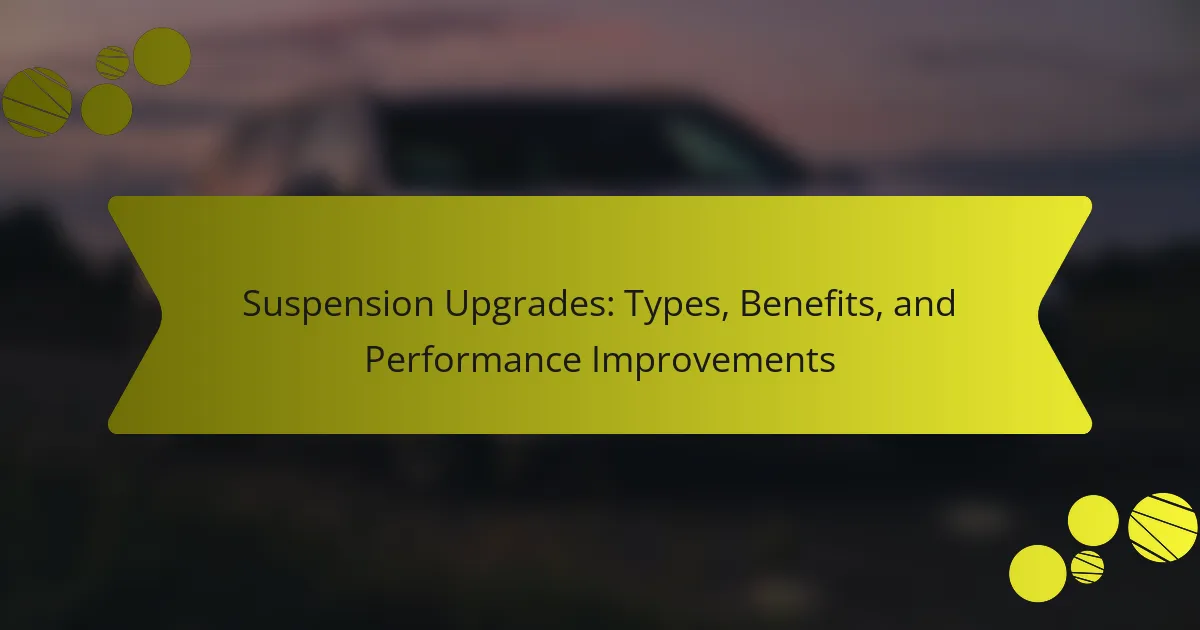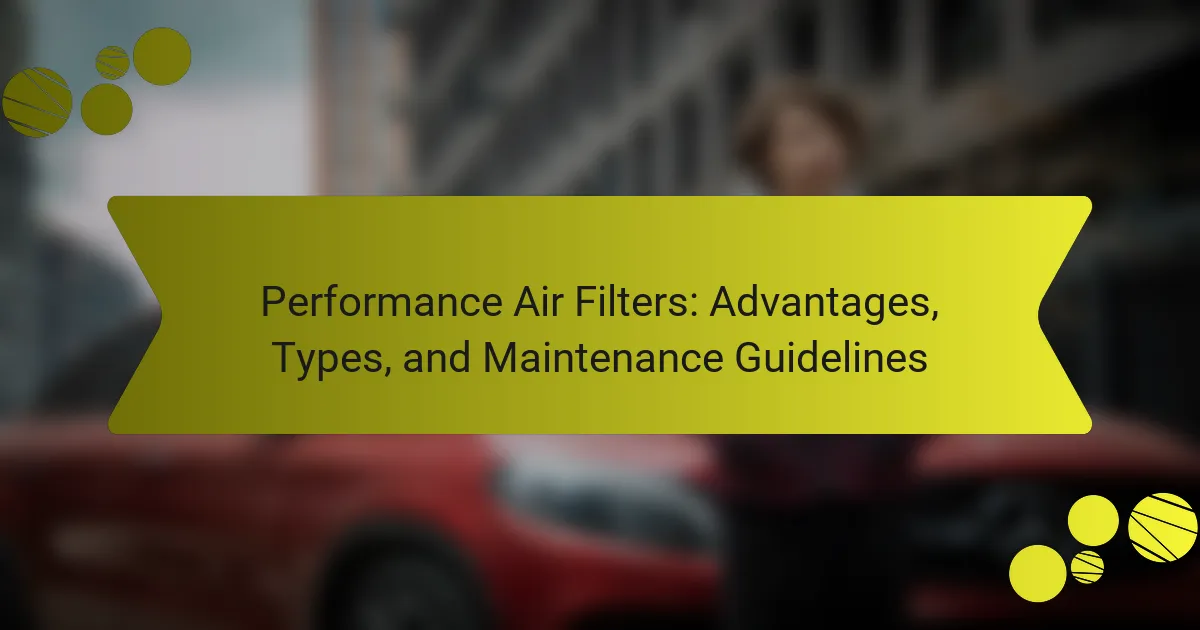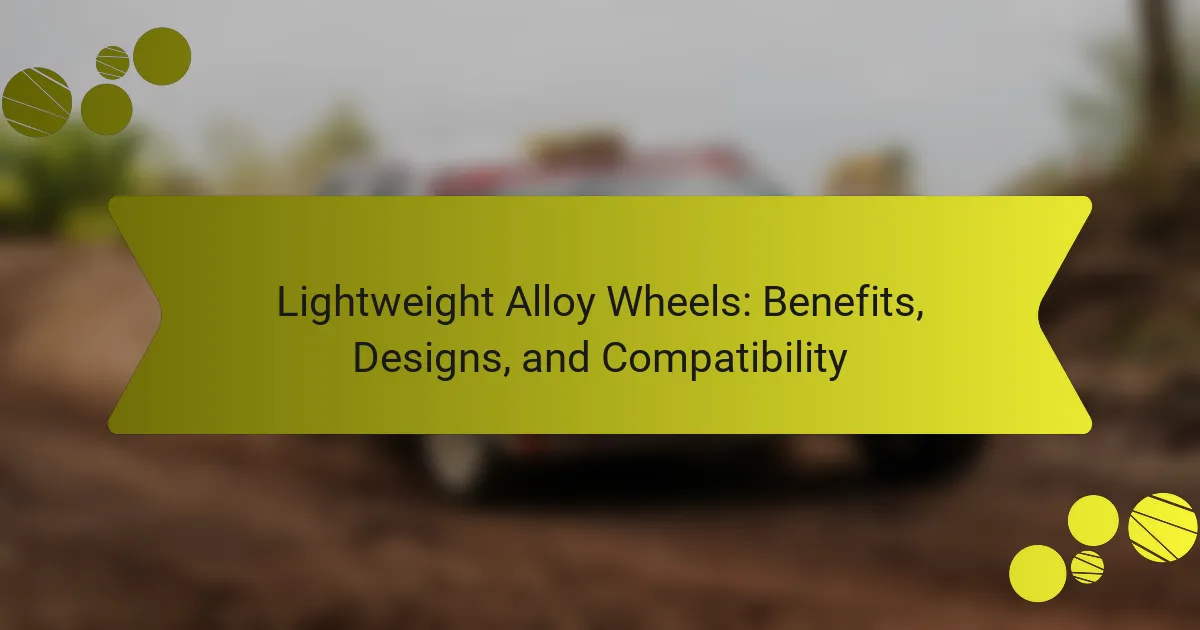Suspension upgrades enhance vehicle handling, ride quality, and stability, leading to improved performance on various terrains. This article covers the types of upgrades available, such as coilovers, air suspension, and sway bars. It also explores the benefits of these enhancements and important considerations for installation and maintenance. Understanding these aspects can help drivers optimize their vehicle’s performance and safety.

What are the key benefits of suspension upgrades?
Suspension upgrades provide enhanced handling, improved ride quality, and increased stability. These benefits lead to better performance on various terrains and during cornering. Upgrades can also reduce body roll and enhance tire contact with the road. Overall, suspension enhancements contribute to a safer and more enjoyable driving experience.
How do suspension upgrades improve ride quality?
Suspension upgrades significantly enhance ride quality by improving handling, comfort, and stability. Upgraded components like shocks and springs absorb road imperfections better, reducing vibrations and bumps. This results in a smoother driving experience and increased vehicle control, especially during turns and on uneven surfaces. Enhanced suspension systems can also lower body roll, making the ride feel more stable and secure.
Which safety enhancements are associated with suspension upgrades?
Suspension upgrades enhance vehicle safety by improving stability, reducing body roll, and increasing traction. These enhancements lead to better handling during turns and emergency maneuvers. Upgraded suspension systems can include features such as adjustable dampers and stiffer springs, which contribute to improved vehicle control and accident avoidance.
What performance improvements can be expected from suspension upgrades?
Suspension upgrades can significantly enhance vehicle performance by improving handling, stability, and ride quality. Upgrades such as coilovers or air suspension allow for better customization of damping and ride height, resulting in superior cornering and comfort. Additionally, upgraded components like sway bars reduce body roll, enhancing overall control during maneuvers. These improvements lead to faster lap times and a more enjoyable driving experience.

Which types of suspension upgrades are available?
Suspension upgrades include coilovers, air suspension, and sway bars. Each type enhances handling, ride comfort, and performance.
Coilovers combine springs and shock absorbers for adjustable ride height and damping. Air suspension offers customizable ride quality and load leveling. Sway bars reduce body roll during cornering, improving stability.
Upgrading suspension can significantly enhance vehicle dynamics and driving experience.
What are the differences between coilovers and air suspension systems?
Coilovers offer adjustable ride height and damping, while air suspension provides adjustable ride height and comfort. Coilovers typically enhance handling, whereas air suspension focuses on ride quality. Coilovers have a fixed spring rate, while air suspension allows for variable spring rates. Coilovers are generally lighter, while air systems can be heavier due to the compressor and air tanks. Both systems improve performance but cater to different driving preferences.
How do performance shocks and struts differ from standard options?
Performance shocks and struts provide enhanced handling and stability compared to standard options. They are designed for improved responsiveness and reduced body roll during cornering. Performance variants often feature stiffer springs and dampers, which can lead to a harsher ride but greater control. Standard options prioritize comfort, offering a softer suspension that absorbs bumps more effectively. The choice between them depends on driving style and desired vehicle dynamics.
What are the advantages of upgrading to adjustable suspension components?
Upgrading to adjustable suspension components enhances vehicle performance, comfort, and handling. These components allow customization of ride height and stiffness, improving adaptability to various driving conditions.
Adjustable suspension can provide better cornering stability, reducing body roll during sharp turns. Additionally, it often results in improved ride quality, as drivers can fine-tune settings for comfort or performance based on personal preferences.
The ability to adjust suspension settings can lead to increased tire longevity by optimizing contact with the road. This upgrade also supports a wider range of driving styles, from daily commuting to competitive racing.
In summary, adjustable suspension components deliver significant benefits in performance, comfort, and customization, making them a valuable investment for any vehicle enthusiast.

How do suspension upgrades affect handling and stability?
Suspension upgrades significantly enhance handling and stability by improving vehicle control and responsiveness. These upgrades optimize tire contact with the road, reducing body roll during cornering. High-performance shocks and struts, for instance, provide better damping, which stabilizes the vehicle. Additionally, upgraded springs can lower the center of gravity, enhancing cornering performance. Overall, these modifications lead to a more predictable and enjoyable driving experience.
What role does suspension geometry play in vehicle performance?
Suspension geometry significantly impacts vehicle performance by influencing handling, ride quality, and stability. Proper geometry ensures optimal tire contact with the road, enhancing grip and responsiveness. For instance, camber angles affect cornering stability, while toe settings influence tire wear and straight-line tracking. Adjusting suspension geometry can lead to improved cornering speed and reduced body roll. These enhancements contribute to a more controlled driving experience, especially in high-performance scenarios.
How can suspension upgrades enhance cornering capabilities?
Suspension upgrades significantly enhance cornering capabilities by improving vehicle stability and responsiveness. Upgraded components, such as coilovers and sway bars, reduce body roll during turns, allowing for better traction and control. This results in sharper handling and a more engaging driving experience. Enhanced damping characteristics also contribute by adapting to road conditions, maintaining tire contact with the surface. Overall, these upgrades lead to increased confidence and performance in cornering situations.

Which factors should be considered when selecting suspension upgrades?
When selecting suspension upgrades, consider factors such as vehicle type, driving conditions, desired performance, and budget. These elements directly impact the effectiveness and compatibility of the upgrades. Assessing ride quality, handling, and durability is crucial for optimal performance improvements. Additionally, consult expert reviews and manufacturer specifications to ensure the upgrades align with your specific needs.
What is the importance of vehicle type and use case in suspension upgrades?
Vehicle type and use case significantly impact suspension upgrades by determining the appropriate components and performance enhancements needed. Different vehicles, such as trucks, sports cars, or SUVs, have unique suspension requirements based on their weight, intended use, and driving conditions. For example, a truck used for towing may require heavy-duty springs, while a sports car benefits from stiffer shocks for better handling. Upgrading suspension systems tailored to these factors enhances ride quality, stability, and overall performance.
How does budget influence the choice of suspension upgrades?
Budget significantly influences the choice of suspension upgrades by determining the quality and type of components available. Higher budgets allow for premium parts that enhance performance, while limited budgets may restrict options to basic upgrades.
For example, a budget of $500 may cover entry-level shocks, while a budget of $2000 can afford high-performance coilovers. The choice between comfort-oriented or performance-oriented upgrades often hinges on financial constraints. Ultimately, the budget shapes the balance between desired performance improvements and available options.

What are common misconceptions about suspension upgrades?
Many believe suspension upgrades only enhance off-road performance, but they also improve on-road handling and comfort. Common misconceptions include the idea that all upgrades are expensive, that they require extensive modifications, and that they are only necessary for racing or heavy-duty vehicles. In reality, affordable options exist, and many upgrades can be installed with minimal changes to the vehicle. Additionally, suspension upgrades benefit daily drivers by providing a smoother ride and better stability.
Do suspension upgrades always lead to a stiffer ride?
Suspension upgrades do not always lead to a stiffer ride. Different types of upgrades, such as adjustable coilovers or air suspension, can enhance comfort while improving handling. The specific upgrade chosen influences ride quality significantly. For instance, air suspension can provide a softer ride compared to traditional upgrades, allowing for customization of stiffness.
Are suspension upgrades only for performance vehicles?
Suspension upgrades are not only for performance vehicles; they can enhance comfort and handling in everyday cars as well. Many drivers seek suspension improvements for better ride quality, stability, and safety. Upgrades can include components like shock absorbers, springs, and sway bars, which can benefit a wide range of vehicles. For example, an upgraded suspension system can reduce body roll and improve cornering for both performance and standard models.
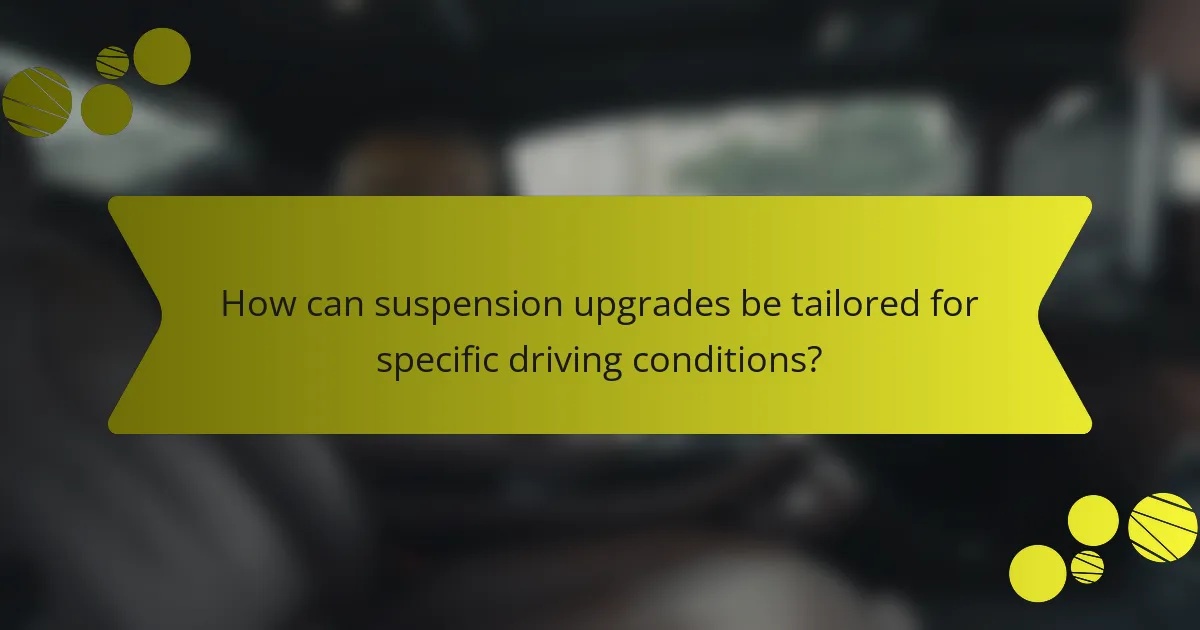
How can suspension upgrades be tailored for specific driving conditions?
Suspension upgrades can be tailored for specific driving conditions by selecting components that match the environment. For off-road driving, consider heavy-duty shocks and springs designed for rugged terrain. For track performance, adjustable coilovers provide fine-tuning for optimal handling. Weather conditions also dictate choices; softer setups work well in wet conditions, while stiffer ones enhance stability in dry conditions. Additionally, unique attributes like adjustable ride height allow customization for specific scenarios, ensuring performance improvements across diverse driving environments.
What adjustments are necessary for off-road versus on-road driving?
Adjustments for off-road driving require enhanced suspension systems compared to on-road driving. Off-road vehicles benefit from specialized suspension upgrades that improve ground clearance and shock absorption, enabling better handling on uneven terrain. Key upgrades include long-travel shocks, reinforced springs, and adjustable dampers, which collectively enhance performance and durability. On-road driving typically prioritizes comfort and stability, utilizing standard suspension systems designed for smooth surfaces.
How do climate and terrain influence suspension choices?
Climate and terrain significantly influence suspension choices by determining the required performance characteristics. For example, rough terrains necessitate durable suspensions that absorb shocks, while smoother surfaces may prioritize comfort and responsiveness. High humidity or extreme temperatures can also affect material durability and flexibility. Additionally, specific climates may require unique attributes, such as rust resistance in coastal areas or enhanced grip in snowy conditions.
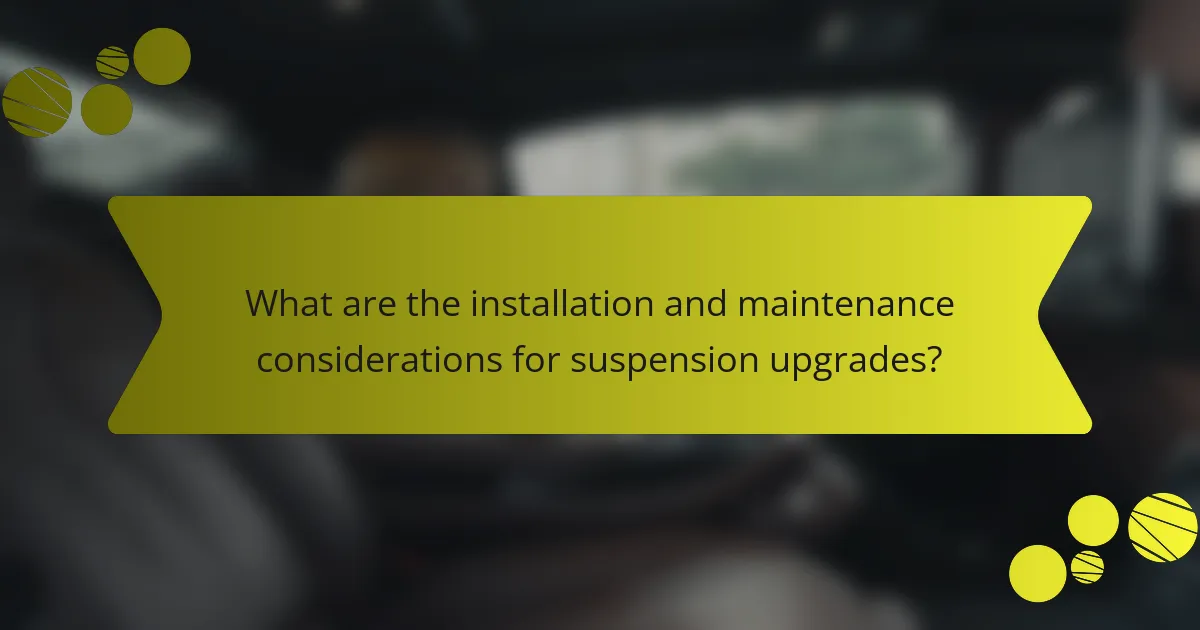
What are the installation and maintenance considerations for suspension upgrades?
Installation and maintenance of suspension upgrades require careful consideration for optimal performance. Key factors include compatibility with existing components, proper alignment, and regular inspections.
1. Compatibility: Ensure new suspension parts fit with the vehicle’s make and model.
2. Installation: Follow manufacturer guidelines for torque specifications and alignment settings.
3. Maintenance: Regularly inspect components for wear and tear, and check fluid levels if applicable.
4. Upgrades: Consider additional enhancements like adjustable dampers for improved handling.
Proper installation and ongoing maintenance enhance the benefits of suspension upgrades, contributing to better vehicle stability and ride quality.
How can DIY installation impact performance and safety?
DIY installation can enhance performance but may compromise safety if not done correctly. Properly executed suspension upgrades improve handling and ride quality. However, inadequate installation can lead to alignment issues, reduced stability, and potential failure of components. Regular inspections and professional guidance are recommended to ensure optimal performance and safety.
What maintenance practices ensure longevity of upgraded suspension systems?
Regular maintenance practices ensure longevity of upgraded suspension systems. Key practices include routine inspections, timely replacements of worn components, and proper alignment checks.
1. Inspect suspension components regularly for wear and damage.
2. Replace shock absorbers and struts as needed to maintain performance.
3. Ensure proper wheel alignment to prevent uneven tire wear.
4. Lubricate moving parts to reduce friction and prolong lifespan.
5. Check and adjust ride height to maintain optimal performance.
6. Monitor fluid levels in adjustable systems to ensure functionality.
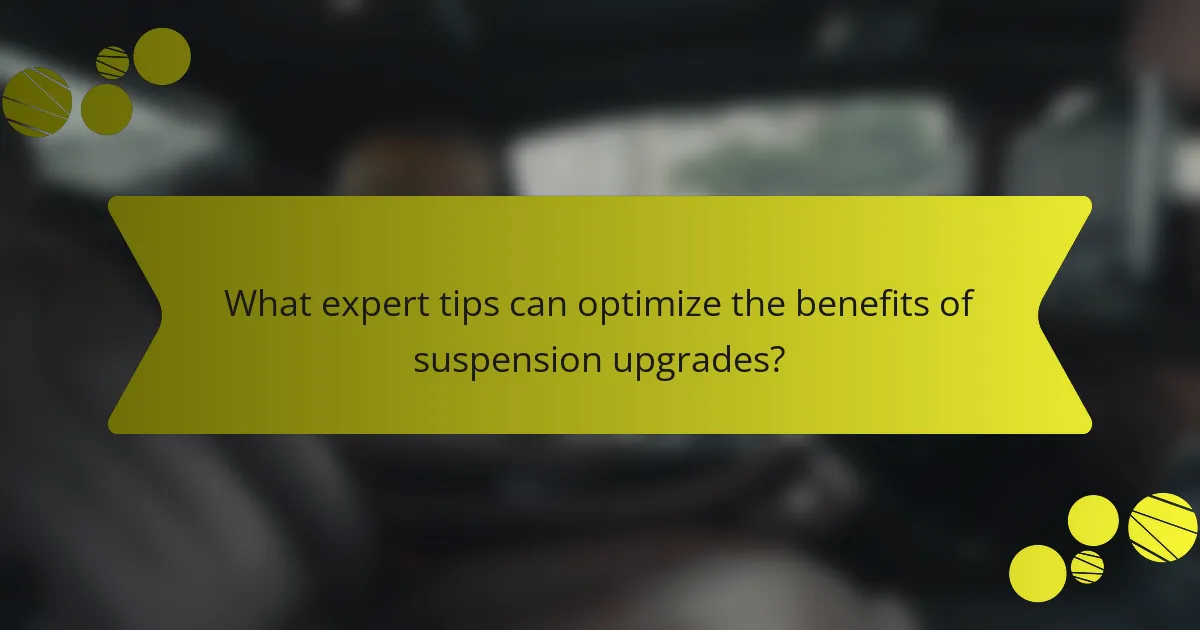
What expert tips can optimize the benefits of suspension upgrades?
To optimize the benefits of suspension upgrades, focus on proper installation, regular maintenance, and selecting compatible components. Ensure alignment adjustments post-installation to enhance performance. Consider upgrading to high-quality dampers for improved handling and ride comfort. Regular inspections can prevent wear and maintain optimal performance.
